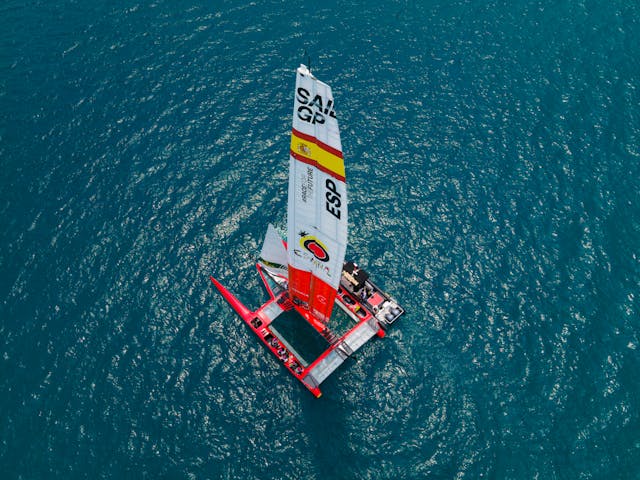Welcome back to GertieBlu! If you’re here, chances are you’re dreaming of the open sea, the sun on your face, and the gentle sway of a boat beneath your feet. But not just any boat—you’re intrigued by catamarans, those sleek, stable vessels that seem to glide effortlessly over the water. Whether you’re a seasoned sailor or just dipping your toes into the world of yachting, catamarans offer a unique blend of comfort, speed, and adventure. Let’s dive into what makes catamarans so special, explore the different types available, and answer the big question: how far can you sail in one?
What is a Catamaran?
A catamaran is a multi-hulled vessel, typically with two parallel hulls of equal size. Unlike monohulls (traditional sailboats with a single hull), catamarans offer greater stability and reduced drag, making them faster and less prone to tipping. Their design provides a spacious deck and living quarters, often making them the preferred choice for long voyages and leisure cruising.

Types of Catamarans
Catamarans come in various shapes, sizes, and configurations, each suited for different types of sailing adventures. Here’s a breakdown of the most common types:
- Sailing Catamarans
- Overview: The most popular type of catamaran, designed primarily for sailing. These boats are powered by wind and can also be equipped with engines for when the wind is scarce.
- Use: Perfect for everything from day trips to long-distance cruising. They are known for their speed, stability, and fuel efficiency.
- Pros: Spacious living quarters, shallow draft (allows sailing closer to shore), excellent stability.
- Cons: More complex sail handling compared to monohulls, higher initial cost.
- Power Catamarans
- Overview: These are motorized catamarans, with no sails. They rely entirely on engines, offering higher speeds and ease of maneuverability.
- Use: Ideal for those who prefer speed and simplicity. Great for coastal cruising, island hopping, and fishing expeditions.
- Pros: Fast, easy to operate, requires less crew, can carry more fuel and equipment.
- Cons: Higher fuel consumption, less efficient in rough seas compared to sailing catamarans.
- Luxury Catamarans
- Overview: These are the crème de la crème of catamarans, designed for those who want to sail in style. They come with all the bells and whistles—think state-of-the-art navigation systems, luxurious interiors, and even onboard Jacuzzis.
- Use: Best suited for luxury charters, long-term cruising, or living aboard.
- Pros: Extremely comfortable, high resale value, customizable.
- Cons: Very expensive, higher maintenance costs.
- Sporting Catamarans
- Overview: Lightweight and designed for speed, these catamarans are built for racing and day sailing.
- Use: Ideal for competitive sailors or those who love the thrill of speed.
- Pros: Fast, agile, and fun to sail.
- Cons: Limited living space, not suitable for long voyages.
How Far Can You Sail in a Catamaran?
One of the biggest questions for any prospective catamaran owner is: How far can I actually sail in one? The answer depends on a variety of factors, including the type of catamaran, weather conditions, crew experience, and your own comfort level.
- Sailing Catamarans: These are capable of crossing oceans. With proper planning, you can sail a well-equipped sailing catamaran around the world. Average speeds range from 8-12 knots, and with favorable winds, you can cover significant distances. For example, a transatlantic crossing typically takes about 2-3 weeks.
- Power Catamarans: These are also capable of long-distance cruising, though their range is limited by fuel capacity. Many power catamarans can cover 1,000-1,500 nautical miles without refueling, making them suitable for coastal cruising and island hopping.
- Luxury Catamarans: These are designed for long-term voyages. With advanced navigation systems, larger fuel tanks, and all the comforts of home, you could theoretically sail around the world in luxury and style.
- Sporting Catamarans: These are not designed for long-distance cruising. They’re built for speed and agility in short races or day sailing, so long voyages would not be comfortable or practical.

Planning Your Voyage
If you’re considering a long-distance trip in a catamaran, here are a few things to keep in mind:
- Route Planning: Whether you’re crossing an ocean or cruising along the coast, detailed route planning is crucial. Consider wind patterns, currents, and stopover points.
- Provisioning: Ensure you have enough food, water, and other supplies. Catamarans often have ample storage, but you’ll need to plan carefully for longer trips.
- Maintenance and Repairs: Be prepared for the unexpected. Carry spare parts and tools for essential repairs, especially if you’re venturing far from shore.
- Safety: Equip your catamaran with necessary safety gear, including life jackets, flares, and a reliable communication system. Knowing how to handle emergencies is key to a successful voyage.
Conclusion
Catamarans offer the perfect blend of adventure and comfort, making them an excellent choice for both short trips and epic journeys. Whether you’re looking to explore coastal waters, island-hop in the Caribbean, or embark on a transoceanic voyage, there’s a catamaran out there to suit your needs. The question isn’t just how far you can sail in one—but how far your dreams will take you. So, hoist the sails, fire up the engines, and let the sea be your guide.
Fair winds and following seas,
GertieBlu









